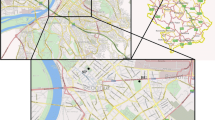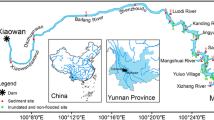Abstract
Concentrations of the elements Al, Be, Cd, Co, Cr, Cu, Fe, Mn, Ni, Pb, V, and Zn were measured in the terrestrial moss Brachythecium rutabulum and the soil on which it grew. Soil and moss plants were sampled at sites situated 1.5, 3, 6, 9 and 15 km to the north, south, east and west of the Legnica copper smelter (SW Poland). The self-organizing feature map (SOFM) or Kohonen network was used to classify the soil and moss samples according to the concentrations of the elements. The self-organizing map yielded distinct groups of B. rutabulum and soil samples, depending on the distance from and direction to the source of pollution. When the map-identified groups of sites with similar soil metal concentrations were combined with the map-identified groups of sites with similar metal concentrations in B. rutabulum, these maps were found to correspond closely. The SOFMs accurately represented the least polluted, moderately polluted and severely polluted sites, reflecting the distribution of metals that is typical of the smelter area, caused by the prevailing westerly and northerly winds.




Similar content being viewed by others

References
Aničić M, Frontasyeva MV, Tomašević M, Popović A (2007) Assessment of atmospheric deposition of heavy metals and other elements in belgrade using the moss biomonitoring technique and neutron activation analysis. Environ Monit Assess 129:207–219. doi:10.1007/s10661-006-9354-y
Bykowszczenko N, Baranowska-Bosiacka I, Bosiacka B, Kaczmarek A, Chlubek D (2006) Determination of heavy metal concentration in mosses of Slowinski National Park using atomic absorption spectrometry and neuron activation analysis methods. Pol J Environ Stud 15:41–46
Dierssen K, Dierssen B (2001) Moore (Ekosysteme Mitteleuropas aus geobotanischer Sicht) [Mires. Ecosystems of Central Europe from the geobotanical viewpoint)]. Verlag Eugen Ulmer, Stuttgart (Hohenheim)
Djingova R, Kuleff I, Markert B (2004) Chemical fingerprinting of plants. Biol Res 19:3–11
Drozd J, Kowaliński S (1977) Zmiany niektórych właściwości gleb pod wpływem zanieczyszczeń emitowanych przez hute miedzi Legnica [Changes of soil properties by pollution of the Legnica smelter]. Rocz Glebozn Warszawa 28:49–75
Duliere JF, De Bruynb R, Malaisseb F (2000) Changes in the moss layer after liming in a Norway spruce (Picea abies (L.) Karst.) stand of eastern Belgium. Forest Ecol Manage 136:97–105
Fabiszewski J, Brej T, Bielecki K (1983) Fitoindykacja wpływu Huty Miedzi na środowisko biologiczne [Phytoindication of the influence of the Legnica smelter on the environment]. Zakład Narodowy im Ossolińskich, Wrocław, 109 pp
Fernandez JA, Rey A, Carballeira A (2000) An extended study of heavy metals deposition in Galicia (NW Spain) based on mosss analysis. Sci Tot Environ 254:31–44
Genoni P, Parco V, Santagostino AS (2000) Metal biomonitoring with mosses in the surroundings of an oil-fired power plant in Italy. Chemosphere 41:729–733. doi:10.1016/S0045-6535(99)00457-9
Goldberg DE (1989) Genetic algorithms in search, optimization, and machine learning. Addison-Wesley, Reading
Helios-Rybicka E (1996) Impact of mining and metallurgical industries on the environment in Poland. Appl Geochem 11:3–9
Helmisaari HS, Makkonen K, Olsson M, Viksna A, Mälkönen E (1999) Fine-root growth, mortality and heavy metal concentrations in limed and fertilized Pinus silvestris (L.) stands in the vicinity of a Cu–Ni smelter in SW Finland. Plant Soil 209:193–200. doi:10.1023/A:1004595531203
Kabata-Pendias A (2001) Trace metals in soils-a current issue in Poland. Acta Univ Wratislaviensis 2317 Prace Bot 79 79:13–20
Kohonen T (1995) Self-organizing maps. Springer, Berlin, Heidelberg, New York
Kozanecka T, Chojnicki J, Kwasowski W (2002) Content of heavy metals in plants from pollution-free regions. Pol J Environ Stud 11:395–399
Lehmann C, Rebele F (2004) Evaluation of heavy metal tolerance in Calamagrostis epigejos and Elymus repens revealed copper tolerance in a copper smelter population of C. epigejos. Environ Exp Bot 51:199–213
Lepp NW, Salmon D (1999) A field study of the ecotoxicology of copper to bryophytes. Environ Pollut 106:153–156
Lis J, Pasieczna A (2005) Anthropogenic soils pollution within the Legnica-Glogów copper district. Pol Geol Inst Spec Papers 17:42–48
Markert B, Herpin U, Berlekamp J, Ochlmann J, Grodzińska K, Mankovska B, Suchara I, Siewers U, Weckert V, Lieth H (1996) A comparison of heavy metal deposition in selected Eastern European countries using the moss monitoring method, with special emphasis on the “Black Triangle”. Sci Total Environ 193:85–100
Markert B, Breure T, Zechmeister H (2003) Bioindication and biomonitors—principles, concepts and applications. Elsevier, Amsterdam
Ötvös E, Pázmándi T, Tuba Z (2003) First national survey of atmospheric heavy metal deposition in Hungary by the analysis of mosses. Sci Total Environ 309:151–160
Rebele F, Surma A, Kuznik C, Bornkamm R, Brej T (1993) Heavy metal contamination of spontaneous vegetation and soil around the copper smelter “Legnica”. Acta Soc Bot Pol 62:53–57
Rühling A (1994) Atmospheric heavy metal deposition in Europe—estimations based on moss analysis. Nordic Council of Ministries, Copenhagen, Nord 9, 44 pp
Rühling A, Tyler G (1968) An ecological approach to the lead problem. Bot Not 122:248–342
Samecka-Cymerman A, Kolon K, Kempers AJ (2005) Differences in concentration of heavy metals between native and transplanted Plagiothecium denticulatum—a case study of soils contaminated by oil well exudates in Southeast Poland. Arch Environ Contam Toxicol 49:317–321
Samecka-Cymerman A, Kosior G, Kempers AJ (2006) Comparison of the moss Pleurozium schreberi with needles and bark of Pinus sylvestris as biomonitors of pollution by industry in Stalowa Wola (southeast Poland). Ecotoxicol Environ Saf 65:108–117
Sokal RR, Rohlf FJ (2003) Biometry. The principles and practice of statistics in biological research. Freeman, New York
StatSoft, Inc. (2008) STATISTICA (data analysis software system), version 8.0. Available at: www.statsoft.com
UNECE (2003) Heavy metals in European mosses, 2000/2001 survey. UNECE ICP vegetation. Buse A, Norris D, Harmens H, Buker P, Ashenden T, Mills G (compilers). Center for Ecology and Hydrology, Bangor University of Wales, Bangor
Zar H (1999) Biostatistical analysis. Prentice Hall, Upper Saddle River, NJ
Author information
Authors and Affiliations
Corresponding author
Rights and permissions
About this article
Cite this article
Samecka-Cymerman, A., Stankiewicz, A., Kolon, K. et al. Bioindication of Trace Metals in Brachythecium rutabulum Around a Copper Smelter in Legnica (Southwest Poland): Use of a New Form of Data Presentation in the Form of a Self-Organizing Feature Map. Arch Environ Contam Toxicol 56, 717–722 (2009). https://doi.org/10.1007/s00244-008-9249-8
Received:
Accepted:
Published:
Issue Date:
DOI: https://doi.org/10.1007/s00244-008-9249-8



